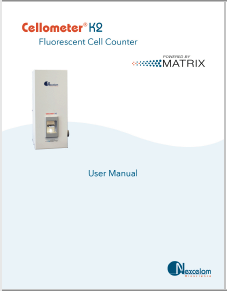User Manual: Cellometer K2 with Matrix
Cellometer® Automated Cell Counters incorporate the basic principles of Imaging Cytometry traditionally used in manual cell counting via hemocytometer into a suite of instruments designed to simplify the cell counting process. By capturing multiple images of cells to be counted, users can adjust parameters based on cell morphology and perform reanalysis as necessary. Cellometer Cell Counting Chambers are equivalent to all four corner squares of a hemocytometer and are disposable, thus saving time and effort, and eliminating any risk of cross-contamination.
Using both Brightfield and Dual-Fluorescent imaging in combination with pattern-recognition software, the Cellometer K2 quickly identifies cells and accurately calculates Cell Count, Mean Diameter (micron) and Cell Concentration (cells/mL). Customizable cell type parameters are designed to assist with the declustering of clumpy cell lines. For cultured cells stained with trypan blue or fluorescent reagents, the K2 simultaneously calculates Live/Dead and Total cell counts, Viability (%), and Live and Total cell concentrations, including a helpful graphic overlay used to highlight live and dead cells with color-coded outlines in the image being viewed.
The minimal footprint of the K2 is designed to fit into small lab spaces and the Matrix software can be loaded onto computers that meet specified requirements. With an Operating Computer connected to the instrument via USB cable, the system can be linked to a network for accessing external files, printers and storing count results. An optional Matrix 21 CFR Part 11 module ensures the integrity of your data by limiting access to authorized users, retaining an audit trail of user transactions, offering electronic signing/unsigning capabilities and providing multi-layer access control via user roles.

